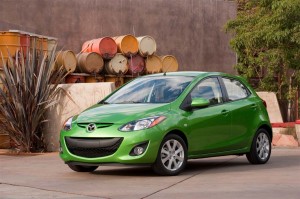Toyota plans to team up with erstwhile Japanese rival Mazda to produce a new small car that would either replace or share the mini-car market with the Japanese giant’s existing Yaris model.
The new model, the two makers today confirmed, will be based on the same platform as the little Mazda2 and will be produced at the factory Mazda is now building in Mexico.
The announcement underscores the shifting strategies redefining the auto industry. Long determined to do just everything on its own, Toyota has been rapidly inking an assortment of alliances with traditional competitors like Ford, BMW, and now Mazda.
For the smaller Japanese maker, the move could be equally significant. The current Mazda2 was developed as part of a long-running alliance with Ford Motor Co. But the U.S. maker has steadily wound down that relationship since Alan Mulally signed on as CEO six years ago, leaving Mazda searching for a new partner.
Earlier this year, Mazda walked away from the assembly plant it had shared with Ford in the Detroit suburb of Flat Rock, shifting production of the Mazda6 back to Japan. The move left it with no North American production base at a time when lopsided exchange rates make imports from Japan more expensive – and less profitable – than ever.
The new Mexican plant will help offset that issue which is particular problematic on small cars that have minimal profit margins in the first place. But considering the relatively modest demand for cars the size of the Mazda2 in the U.S., analysts had been wondering how the small and struggling Japanese maker would justify the hefty cost of the new facility.
The new Toyota alliance appears to change the equation – for both makers. Toyota has struggled to gain traction in the mini-car market, its Yaris being the weakest of the offerings from the major Japanese makers.
But, it’s not clear exactly what Toyota has planned and neither of the new partners is offering specifics. So, it is possible that the new Mazda2-based Toyota could replace the existing Yaris, come in as a second model in that segment – or even provide another product for Toyota’s youth-oriented Scion brand. Until recently, Scion had a policy of offering a maximum three models, but that approach has been abandoned and it is expanding its range with products such as the new FR-S sports coupe.
The Toyota version of the Mazda2 is expected to roll into U.S. showrooms – and likely reach other markets as well – during the summer of 2015. Mazda plans to produce about 50,000 a year for its new partner.
The plant will have an overall capacity of 140,000, Mazda says, with employment expected to reach 3,000.
The smaller maker’s decision to tie up with Toyota takes no one by surprise, as CEO Takashi Yamanouchi has said his company is “actively” looking for alliance partners.
Toyota, meanwhile, has shifted rapidly from a traditional go-it-alone strategy that saw it engage in only a few partnerships over the decades – though that included a manufacturing joint venture with General Motors near San Francisco, dubbed NUMMI, that gave Toyota its first taste of U.S. manufacturing.
Though that venture closed more than a year ago, Toyota has turned to Subaru to produce some Camry sedans at a plant in Indiana. And Subaru partnered with the bigger maker to develop a new sports coupe sold in the U.S. as both the Scion FR-S and Subaru BRZ.
Meanwhile, Toyota has also formed limited alliances with both Ford and BMW to help develop advanced powertrain technologies, and the California-based electric vehicle maker, Tesla Motors, provided the driveline for the new RAV4-EV. Tesla and Toyota also plan to develop a new battery-based sports car.
“No one can handle it all by themselves,” explained Yoshi Inaba, president and COO of Toyota Motor North America, during an interview with TheDetroitBureau.com.

